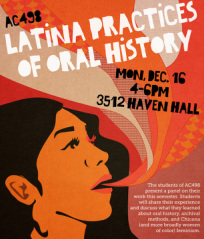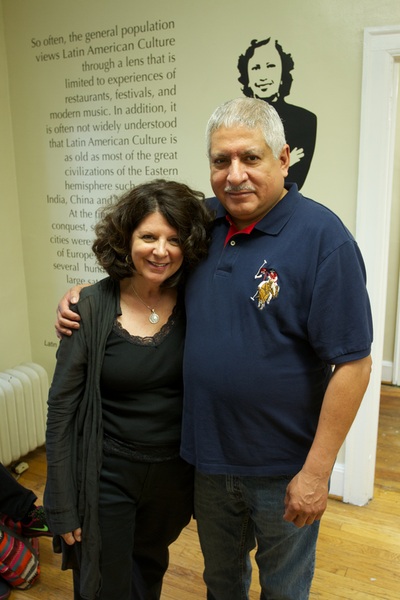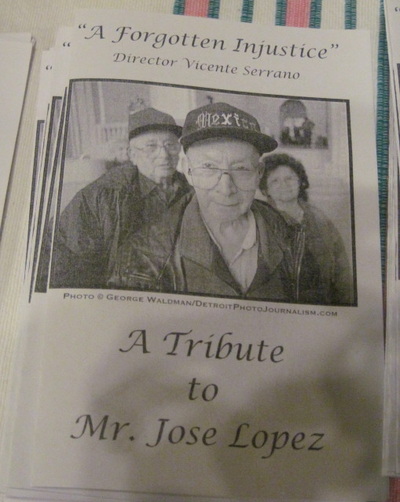Events and Exhibits
2017 Exihibit: Chicana Fotos/Nancy De Los Santos

Chicana Fotos\Nancy De Los Santos
An exhibition of Chicana photography documenting the 1970s
OPENING RECEPTION: Friday, February 17, 2017
TIME: 4:00 PM - 7:00 PM
PLACE: 5401 Cass Ave, Detroit, MI 48202 -- Walter P. Reuther Library at Wayne State University
Gallery Talk with Nancy De Los Santos and exhibition curator Maria Cotera
February 17, 12:00pm, Woodcock Conference Room,
Walter P. Reuther Library, Wayne State University
Gallery Talk sponsored by the Center for Latina/o and Latin American Studies, Wayne State University and the University of Michigan’s Third Century Initiative
Exhibit Hours: Monday - Friday 10:00am - 4:00pm
EXHIBIT DURATION: February 17-April 14, 2017
Find this event on facebook!
An exhibition of Chicana photography documenting the 1970s
OPENING RECEPTION: Friday, February 17, 2017
TIME: 4:00 PM - 7:00 PM
PLACE: 5401 Cass Ave, Detroit, MI 48202 -- Walter P. Reuther Library at Wayne State University
Gallery Talk with Nancy De Los Santos and exhibition curator Maria Cotera
February 17, 12:00pm, Woodcock Conference Room,
Walter P. Reuther Library, Wayne State University
Gallery Talk sponsored by the Center for Latina/o and Latin American Studies, Wayne State University and the University of Michigan’s Third Century Initiative
Exhibit Hours: Monday - Friday 10:00am - 4:00pm
EXHIBIT DURATION: February 17-April 14, 2017
Find this event on facebook!
In May 2015 our very own Texas-based curator, art historian and artist Dr. George Vargas, collaborated with local artist Vito Valdez and Detroit area residents to create a portable mural of Frida Kahlo at the DIA. The project was in conjunction with the museum's exhibit: Diego and Frida in Detroit.
 Dr. George Vargas with artist Nora Chapa Mendoza
Dr. George Vargas with artist Nora Chapa Mendoza
Portable Mural Project
By Dr George Vargas, Art Historian and Artist
On Sunday May 17, 2015, at Detroit Institute of Arts (DIA), Detroit artist and educator Vito Valdez and I presented a hands-on mural workshop in conjunction with the DIA’s Frida Kahlo and Diego Rivera Retrospective Exhibition. (Workshop was free or no cost to the public). I first lectured on Kahlo and Rivera in Detroit, 1932-1933, and emphasized their lasting influence on American and Latino art. Then Vito and I organized teams of participants from the audience to work on two individual 4’ by 6’ mural panels. We explained general approaches in mural painting: free hand rendering, use of a cartoon (large scale drawing), the grid, and tracing. Vito’s team relied on the grid method and worked on a mural that interpreted Rivera’s DIA frescoes Detroit Industry. Team Vargas painted Portrait of Frida using the tracing method. The preceding Friday at the DIA Education Center, I had traced a digital design of Kahlo, that I earlier produced with Kim, a graphics art student back at my school Texas A & M University, Kingsville; using a computer and LCD projector, I projected the digital image on the blank panel and traced Kahlo on to the surface with a black pencil. That Sunday, volunteer participants simply filled in the traced image with paint, referring to color reproductions of the original design that I had taped to the wall on either side of the panel. I did not paint much only guiding the volunteers, encouraging them to do it themselves. (Done in 3 and ½ hours!) Team Vargas: Chicana artist Nora Mendoza, Carole Lee, Janet, Nada, and three young students (Kate, Ashley, and Anya).
By Dr George Vargas, Art Historian and Artist
On Sunday May 17, 2015, at Detroit Institute of Arts (DIA), Detroit artist and educator Vito Valdez and I presented a hands-on mural workshop in conjunction with the DIA’s Frida Kahlo and Diego Rivera Retrospective Exhibition. (Workshop was free or no cost to the public). I first lectured on Kahlo and Rivera in Detroit, 1932-1933, and emphasized their lasting influence on American and Latino art. Then Vito and I organized teams of participants from the audience to work on two individual 4’ by 6’ mural panels. We explained general approaches in mural painting: free hand rendering, use of a cartoon (large scale drawing), the grid, and tracing. Vito’s team relied on the grid method and worked on a mural that interpreted Rivera’s DIA frescoes Detroit Industry. Team Vargas painted Portrait of Frida using the tracing method. The preceding Friday at the DIA Education Center, I had traced a digital design of Kahlo, that I earlier produced with Kim, a graphics art student back at my school Texas A & M University, Kingsville; using a computer and LCD projector, I projected the digital image on the blank panel and traced Kahlo on to the surface with a black pencil. That Sunday, volunteer participants simply filled in the traced image with paint, referring to color reproductions of the original design that I had taped to the wall on either side of the panel. I did not paint much only guiding the volunteers, encouraging them to do it themselves. (Done in 3 and ½ hours!) Team Vargas: Chicana artist Nora Mendoza, Carole Lee, Janet, Nada, and three young students (Kate, Ashley, and Anya).
(photos courtesy of Jessica Gudea Vargas and Emily Brower)
Diego and Frida in Detroit is a fantastic exhibition, documenting the time that Mexican artists Diego Rivera and Frida Kahlo spent in Detroit (1932-1933) while Rivera worked on his commissioned mural "Detroit Industry." The exhibition will be on display at the DIA through July 15. For more on the exhibition see, Frida Kahlo & Contemporary Thoughts. For information on tickets and related events see the Detroit Institute of the Arts Website.
Dia De Los Muertos 2013
|
Come celebrate Dia de los Muertos at the Boulevard House!
exhibit and activities, pan de muerto, friends and family Saturday/Sunday (Nov. 1 & 2) |

La Rebeldes: Stories of Strength and Struggle in Southeastern Michigan Featuring interviews and archives collected from: Jane Garcia, Emily Martinez, Elena Herrada, and Maria Guadiana Open for Dia de los Muertos Saturday/Sunday (Nov. 1 & 2) 12-5pm Boulevard House 412 W. Grand Blvd. If you would like to schedule a small group or classroom tour, please contact: elmuseodelnorte@gmail.com |

History is a collective story crafted from the memories and documents of individual people. In Las Rebeldes we highlight the personal histories of Latinas in southeastern Michigan and explore how they intersect with—and illustrate—broader histories of Latina/o settlement and survival in the Midwest. Las Rebeldes was developed and designed by students and faculty at the University of Michigan in collaboration with members of the Latina/o community in Southeastern Michigan. In the Fall of 2013, students from professor María Cotera’s “Latina Practices of Oral History” class collected oral history interviews as well as documents, letters and photographs from Jane Garcia, Emily Martinez, Elena Herrada, and Maria Guadiana. In the winter of 2014, students from Professor Hannah Smotrich’s “Designing for Exhibition” class shaped these materials into an historical exhibit that offers a picture, both individual and collective, of Latina/o life in Michigan.
Listen to an interview with on of the curators on WDET
Please contact elmuseodelnorte@gmail.com for more information. You can download the press release here.
Sponsored by the Teaching for the Third Century Initiative, University of Michigan, The Boulevard House, El Museo del Norte, The Chicana por mi Raza Digital Archive, Latina/o Studies Program, University of Michigan, Museum Studies Program, University of Michigan, Penny Stamps School of Art and Design, University of Michigan, School of Social Work, University of Michigan
Pictures from our opening!
Listen to an interview with on of the curators on WDET
Please contact elmuseodelnorte@gmail.com for more information. You can download the press release here.
Sponsored by the Teaching for the Third Century Initiative, University of Michigan, The Boulevard House, El Museo del Norte, The Chicana por mi Raza Digital Archive, Latina/o Studies Program, University of Michigan, Museum Studies Program, University of Michigan, Penny Stamps School of Art and Design, University of Michigan, School of Social Work, University of Michigan
Pictures from our opening!
Exhibits, Events & Pop-ups (2012-2013)
Reflexiones/We are not Undocumented
In the Spring of 2012, El Museo del Norte sponsored its first "pop-up" exhibit in partnership with CLAVE and local photographer Lisa Luevanos. The exhibit, entitled “We are not Undocumented,” was curated through the collective efforts of core committee members (Elena Herrada, Lisa and Mary Luevanos) who provided family archives, UM graduate students in History Nicole Greer and Antonio Ramirez (who completed research in local libraries, helped to curate the display, and wrote text to accompany the images), and Mick Kennedy, who, along with project director Maria Cotera, helped design and hang the show. “We are Not Undocumented” was developed in coordination with "Reflexiones," a retrospective exhibit of Lisa Luevanos's photographs curated by Jennifer Garcia Peacock and featuring the photographs of Museo del Norte task force member Lisa Luevanos, which opened on the same night (May 4) next door at Cafe con Leche. The two shows brought together arts and history in an effort to embody the objectives of the El Museo del Norte project — to educate and to inspire — and to get community members to think about the importance of history and the arts to the sustenance and survival of Latina/o communities.
In the Spring of 2012, El Museo del Norte sponsored its first "pop-up" exhibit in partnership with CLAVE and local photographer Lisa Luevanos. The exhibit, entitled “We are not Undocumented,” was curated through the collective efforts of core committee members (Elena Herrada, Lisa and Mary Luevanos) who provided family archives, UM graduate students in History Nicole Greer and Antonio Ramirez (who completed research in local libraries, helped to curate the display, and wrote text to accompany the images), and Mick Kennedy, who, along with project director Maria Cotera, helped design and hang the show. “We are Not Undocumented” was developed in coordination with "Reflexiones," a retrospective exhibit of Lisa Luevanos's photographs curated by Jennifer Garcia Peacock and featuring the photographs of Museo del Norte task force member Lisa Luevanos, which opened on the same night (May 4) next door at Cafe con Leche. The two shows brought together arts and history in an effort to embody the objectives of the El Museo del Norte project — to educate and to inspire — and to get community members to think about the importance of history and the arts to the sustenance and survival of Latina/o communities.
We Will be Heard!
We wanted to make our 2012 Spring pop-up exhibit an annual tradition, so in June of 2013 we created an exhibit to celebrate the opening of the Boulevard House, our new partnership with People's Community Services and the School of Social Work. An exhibit designed by El Museo del Norte task force members Elena Herrada, Maria Cotera, Aimee VonBokel and Mick Kennedy, with contributions from Lolita Hernandez, Mike Garcia, Elisa Gurule, Daniel Martinez, Tom Cervenak, and Nora Chapa Mendoza. “We Will be Heard!” celebrated long-standing community efforts to craft a space for the preservation and nurturance of Latina/o arts, culture and history in Michigan and the Midwest. The exhibit featured voices from the community, as well as an interactive timeline documenting the past, present, and future of the museum idea.
We wanted to make our 2012 Spring pop-up exhibit an annual tradition, so in June of 2013 we created an exhibit to celebrate the opening of the Boulevard House, our new partnership with People's Community Services and the School of Social Work. An exhibit designed by El Museo del Norte task force members Elena Herrada, Maria Cotera, Aimee VonBokel and Mick Kennedy, with contributions from Lolita Hernandez, Mike Garcia, Elisa Gurule, Daniel Martinez, Tom Cervenak, and Nora Chapa Mendoza. “We Will be Heard!” celebrated long-standing community efforts to craft a space for the preservation and nurturance of Latina/o arts, culture and history in Michigan and the Midwest. The exhibit featured voices from the community, as well as an interactive timeline documenting the past, present, and future of the museum idea.
Dia de los Muertos (2012-2013)
A Tribute to Señor Lopez (2012)
El Museo del Norte has made it a tradition to celebrate community history on Day of the Dead. In 2012, we commemorated the passing of our beloved elder, Señor José Lopez, who central the recovery of the history of Mexican repatriation in 1930s Detroit, with the Detroit premiere of the documentary film, "A Forgotten Injustice" (about Mexican repatriation). The screening was hosted by St. Peters Episcopal Church, and was followed by a Q&A with director Vicente Serrano and a reception.
A Tribute to Señor Lopez (2012)
El Museo del Norte has made it a tradition to celebrate community history on Day of the Dead. In 2012, we commemorated the passing of our beloved elder, Señor José Lopez, who central the recovery of the history of Mexican repatriation in 1930s Detroit, with the Detroit premiere of the documentary film, "A Forgotten Injustice" (about Mexican repatriation). The screening was hosted by St. Peters Episcopal Church, and was followed by a Q&A with director Vicente Serrano and a reception.
Dia de los Muertos at the Boulevard House (2013)
For Dia de los Muertos in 2013, we created three commemorative ofrendas at the Boulevard House. Alejandra Villegas designed an ofrenda to honor the memory of the disappeared young women in Juarez, Mexico. Elena Herrada's ofrenda commemorated the Braceros who lost their lives in a plane crash in California in the 1940s. Maria Cotera created an ofrenda to honor the life and work of community historian Dr. Luci Gajec. Detroit Filmmaker Donna Terek dropped by the Boulevard House and produced this beautiful short film featuring Elena Herrada reading her poem to Señor Lopez.
For Dia de los Muertos in 2013, we created three commemorative ofrendas at the Boulevard House. Alejandra Villegas designed an ofrenda to honor the memory of the disappeared young women in Juarez, Mexico. Elena Herrada's ofrenda commemorated the Braceros who lost their lives in a plane crash in California in the 1940s. Maria Cotera created an ofrenda to honor the life and work of community historian Dr. Luci Gajec. Detroit Filmmaker Donna Terek dropped by the Boulevard House and produced this beautiful short film featuring Elena Herrada reading her poem to Señor Lopez.
























